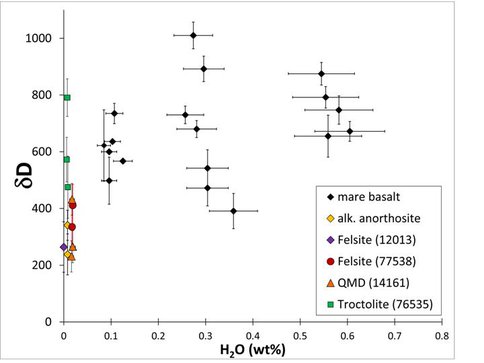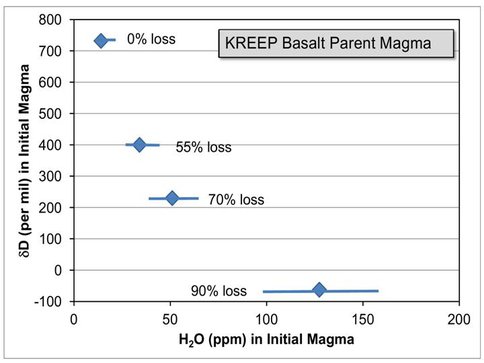2012 Annual Science Report
 University of Hawaii, Manoa
Reporting | SEP 2011 – AUG 2012
University of Hawaii, Manoa
Reporting | SEP 2011 – AUG 2012
Water in the Moon
Project Summary
The discovery in 2008 that the Moon contains at least some water has important implications for the origin of the Earth-Moon system and planetary accretion in general, the source of water for the Earth, and the processes involved in lunar differentiation. We have concentrated our studies on a class of lunar samples that ought to contain the most H2O, so-called KREEP rocks (rich in potassium, rare earth elements, phosphorous, and other elements with similar geochemical behavior, including H2O). We find that these rocks contain considerably less H2O than do mare basalt and pyroclastic deposits measured by others, possibly suggesting that the Moon contained little water during its initial differentiation, implying a post-accretion addition.
Project Progress
We have analyzed OH concentrations in the mineral apatite, using our Cameca 1280 SIMS. The distinguishing feature of our work is that we have concentrated on rocks that are rich in trace elements that do not readily enter into major minerals as magma crystallizes, such as the rare earth elements. Specifically, we have been working on samples that are associated with KREEP basalt magmas. H2O should also be highly enriched in these samples, according to well established understanding of how the lunar magma ocean (the primary lunar differentiation event) crystallized. Equally important, we have focused our attention on samples whose mineralogy and rock textures indicate crystallization in magma bodies that intruded at depth in the lunar crust. The higher pressure associated with these samples allows water to remain dissolved in the magma, preventing loss and D/H fractionation. We also measured the H content in a glassy KREEP basalt. The results show unambiguously that KREEP has much less water (possibly a factor of 100 less) than mare basalt and glassy mare deposit formed by fire fountains on the ancient Moon. In addition, D/H is distinctly higher in lunar water than in the Earth. While we cannot yet rule out that the initial lunar D/H was similar to that of the Earth (some processes do fractionate the two isotopes), it seems likely that lunar water has higher D/H than does terrestrial water. It is also possible that the water in KREEP is primary – accreted to the Moon when it formed – while the water in mare basalts and pyroclastic deposits was added after the magma ocean had crystallized. Deciding between alternative sources of water will require additional analyses and modeling to understand D/H fractionation in the proto-lunar disk and in magmas generated inside the Moon. Disk processes are being studied in collaboration with Steve Desch at Arizona State University.
Plot showing delta D value (normalized to Vienna Standard Mean Ocean Water) with wt% H2O of Greenwood et al. (2011) apatite data and our own data points. Our November detection
limit was detection limit of 110 ppm H2O, which we have driven down by improved analytical procedures to 25 ppm. All KREEP samples are strikingly lower than those of mare basalts, from which we infer that the regions of the lunar interior in which KREEP basalt formed contained about 100 times less H2O than those in which mare basalts formed
Estimate of initial delta D in KREEP basalt magma versus the initial H2O content in the magma. It is based on H2O in glass in rapidly-cooled KREEP basalt clasts in rock 15358, which has relatively high delta D (732 on average). If the lava flow began with the dD value measured for an evolved KREEP basalt (200-400), it would have lost 55-70% of its initial water as H or D. If it began with delta D like that of the terrestrial ocean (-62) the magma would have to have lost 90% of its initial hydrogen
-
PROJECT INVESTIGATORS:
-
PROJECT MEMBERS:
Jeff Taylor
Project Investigator
Gary Huss
Co-Investigator
Steven Desch
Collaborator
Kazuhide Nagashima
Collaborator
Lydia Hallis
Postdoc
Katharine Robinson
Graduate Student
-
RELATED OBJECTIVES:
Objective 1.1
Formation and evolution of habitable planets.

